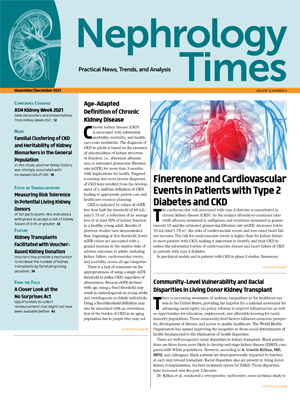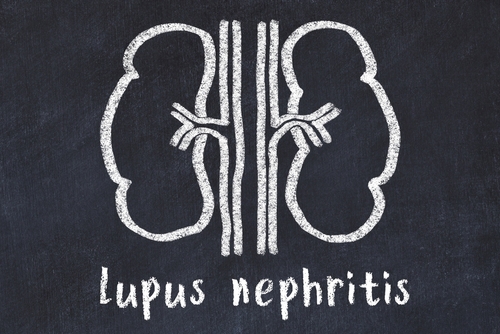
The prevalence of chronic kidney disease (CKD) in the adult population in Europe is estimated at between 3.3% and 17.3%. There are strong associations between CKD and increased risk of cardiovascular events as well as progression to kidney failure. Hypertension and diabetes are established risk factors for CKD, accounting for 50% to 70% of all cases. Familial clustering of CKD and kidney-related markers may indicate that genetic factors or shared environmental factors also play a role in the pathogenesis of CKD.
Jia Zhang, PhD, and colleagues conducted a study designed to quantify the familial aggregation of CKD and to gather heritability estimates of kidney traits and related kidney markers in the general population. Results of the study were reported in the American Journal of Kidney Diseases [2021;77(6):869-878].
The cross-sectional family study utilized baseline data from the Lifelines Cohort Study and Biobank, a multidisciplinary prospective population-based study conducted in the northern Netherlands. The study had a 3-generational design that included 167,648 participants, >95% with European ancestry. The primary outcome of interest was CKD, defined as estimated glomerular filtration rate (eGFR) <60 mL/min/1.73 m2 measured using the CKD Epidemiology Collaboration creatinine equation (CKDScr). In a subgroup with available data on urinary albumin concentration (n=59,943), urinary albumin excretion was expressed as the rate of urinary albumin excretion (UAE) per 24 hours or urinary albumin-creatinine ratio (UACR).
Of the 167,548 Lifeline participants at baseline, the current study included 155,911 participants, within 29,703 family clusters; 39,836 singletons, who had eGFR data available at the baseline visit. A subsample with both eGFR and UACR data included 59,938 participants (including 743 juveniles), and a subsample of 59,145 adults had both eGFR and UAE data available.
In the overall cohort (n=155,911), 58.1% were female, mean age was 43.1 years, mean eGFR was 97.2 mL/min/1.73 m2. In the subgroup with albuminuria measurements, median UAE was 3.86 mg/d and median UACR was 2.72 mg/g. Among males, the kidney risk profile (higher prevalence of smoking, hypertension, diabetes and high cholesterol) was slightly less favorable than among females. Distribution of CKD risks and kidney markers (eGFR and UAE) was similar between men and women.
Kidney profile was slightly less favorable among participants with a family history of CKDScr compared with those without a family history. The distributions of age, sex, and covariates in the subsample were similar to those in the full sample.
The crude prevalence of CKDScr was 1.19% (1,862 cases). In 5.8% of family clusters (n=1725/29,703 families), there was at least one case of CKDScr. A total of 2211 individuals had at least one first-degree relative with CKDScr. Of those, 1680 had at least one affected parent, 56 had at least one affected offspring, and 499 had at least one affected sibling.
Among participants >60 years of age, the prevalence of CKDScr increased dramatically. Mean eGFR was lower at higher age, and age-specific mean values of eGFR were lower among those with affected first-degree relatives than among the general population. Among those with a first-degree relative affected by CKDScr, the age-specific prevalence rates were significantly higher. In the subsample, the crude prevalence rates of CKDScr+UAE and CKDScr+UACR were 5.5% and 6.8%, respectively.
In analyses of recurrence risk ratio (RRR) for CKDScr, having a first-degree relative affected by CKDScr was generally associated with an RRR of 3.04 (95% confidence interval [CI], 2.26-4.09). There was no clear pattern in familial recurrence by kinship type or sex of the affected family member. The risk among spouses of affected individuals was higher than that of the general population (RRR, 1.56; 95% CI, 1.20-2.00).
In RRR analyses in the subsample (~60,000 participants), the prevalence of CKDScr+UAE was higher than that of CKDScr. Among those with an affected first-degree relative, CKDScr+UAE was more prevalent, although the trend was less pronounced than that for CKDScr. The subsample RRR for CKDScr+UAE was 1.34 (95% CI, 1.14-1.58); for CKDScr, the RRR was 2.35 (95% CI, 1.74-3.17). Results were similar when albuminuria was measured using UACR rather than UAE.
In analyses using CKDUAE, those with a first-degree relative affected by CKDUAE had, on average, higher UAE. There was a higher prevalence of CKDUAE observed among those with an affected first-degree relative. The RRR for CKDUAE was 1.60 (95% CI, 1.26-2.03). The risk was elevated primarily in those with an affected mother or sibling. There was no elevated spousal risk. Results for CKDUACR were similar.
Estimates of heritability were 44% for EGFR, 20% for UAE, and 18% for UACR. For the kidney markers, the estimates were 31% for serum urea, 37% for creatinine, and 48% for uric acid. Estimates for serum electrolytes ranged from 22% to 28%. In the subsample, the heritability estimates were similar but less precise. After accounting for household or spousal effects, the estimates did not change, and there was no substantial change after inclusion of additional covariates.
The researchers cited some limitations to the study findings, including 24-hour albuminuria measurements being available for only 60% of the study cohort, estimating rather than measuring GFR, lack of data on kidney biopsy, the possibility of underestimating RRRs, the low prevalence of CKD in the study population, and the inability to generalize the findings to ancestries other than European.
“In summary, we demonstrate that CKD clusters in families in the general population, given that risk of CKD was sternly elevated in those with an affected relative,” the researchers said. “Considerable heritability (20-50%) of kidney traits was observed. Therefore, much of the familial clustering may be attributed to genetic factors. The data presented in this study inform future work on risk stratification based on family history, and provide a step forward in disentangling genetic and environmental risk factors in CKD.”
Takeaway Points
- Researchers utilized data from the Lifeline Cohort Study to quantify familial clustering of chronic kidney disease (CKD) in the general population and to examine the extent to which kidney traits could be explained by genetic and environmental factors.
- In participants with at least one first-degree relative affected by CKD, the risk of CKD was three times higher than that in the total sample.
- The heritability of kidney traits and related biomarkers ranged from moderate to high, indicating the role of genetic factors in risk of CKD.







 © 2025 Mashup Media, LLC, a Formedics Property. All Rights Reserved.
© 2025 Mashup Media, LLC, a Formedics Property. All Rights Reserved.